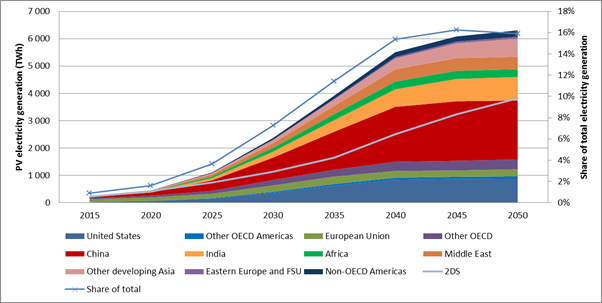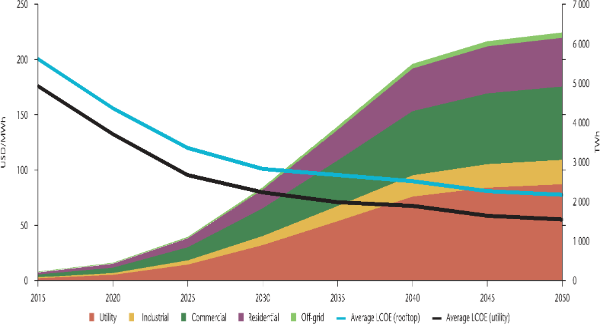
Sending chills down the spine of nuclear and coal utility executives across the world, the International Energy Agency (IEA) yesterday released two reports that assert solar power could become the dominant source of global electricity production by mid-century.
This is the same IEA that has consistently and dramatically underestimated the potential contribution of renewables over more than a decade. As we pointed out on July 17, 2014, since at least 2000, Greenpeace has been far more accurate when projecting renewable energy use than the IEA. As RenewEconomy, based in Australia, put it, “The forecasts from the IEA are not the most dramatic that can be found, but they are significant because the IEA is essentially a conservative organisation that was created in the 1970s to defend developed countries’ access to fossil fuels.”
Yet, in what will almost certainly prove to be another underestimation, even the IEA says that given the right policies (which is certainly not a given) solar power could account for 27% of all global electricity generation by 2050–the most of any power source. IEA says that 16% of this would come from photovoltaics (PV)–mostly rooftop solar–and 11% from utility-scale concentrating solar power (CSP).
The reports drew the attention, for good reason, from publications as diverse as Fortune and Grist (which explains the reports and the underlying issues particularly well).
Reports like this scare nuclear industry execs to death because even the current solar power reality, with rooftop solar still providing less than 1% of U.S. electricity according to most estimates, gives them severe heartburn. Since rooftop solar doesn’t show up in government statistics as electricity generated, but rather as part of the overall drop in electricity demand, estimates are rather unreliable, although it remains a tiny part of current U.S. electricity by any estimate. But rooftop solar and PV generally are easily the fastest growing electricity sources in the U.S., and much of the rest of the world as well.
And when you make your living selling uneconomic nuclear power, or dirty coal-generated electricity, the skyrocketing deployment of solar power–especially when combined with rapid growth of wind and other renewables as well–is an impending omen of bad times ahead. It’s like a tornado off in the distance that you can see growing in size as it approaches the exact spot where you’re standing and you know there’s no way to escape.

But the nuclear and coal industries are trying futilely to escape nonetheless, by attacking renewables at every opportunity and seeking to scale back programs that encourage their use. These programs exist because renewables are not only cleaner than nuclear and coal–good for our climate, good for our air, good for our water and thus good for ourselves–but now renewables are cheaper too.
The pushback against solar has become so strident that NPR has noticed it. So have others, like the generally pro-nuclear Vox. And it’s not just in the U.S., nuclear utilities worldwide are seeking to stem the inevitable advance of solar power because it presents a very real threat to their bottom lines. As Planet Ark reported yesterday,
“The low power prices are leaving a trail of blood in our balance sheet,” RWE Chief Financial Officer Bernhard Guenther said in May, reporting first-quarter operating profit fell by a fifth.
RWE is a major German utility that bet heavily that Germany’s Energiewende transition to a clean energy economy would fail, and the country would be forced to continue substantial nuclear and coal use. It was a bad bet.
Last week we reported that Exelon is seeking a rate increase in Illinois that would give it $580 million/year just for its promise–one it already has said it may not keep anyway–to keep five uneconomic reactors operating. So far, the response has probably not been what Exelon was looking for: while the Nuclear Energy Institute jumped in with its unqualified support for Exelon’s proposal to fleece ratepayers, from normally supportive Illinois legislators, there have been only crickets. And one of Exelon’s major competitors, the relatively-progressive NRG Energy, said it would lobby against Exelon’s proposal.
That doesn’t mean, of course, that Exelon won’t get what it wants. It will take serious campaigning to defeat their proposal. And that, from just about any objective viewpoint, solar power is preferable to dirty, dangerous and increasingly uneconomic nuclear and coal plants doesn’t necessarily mean policymakers will take the right steps to encourage solar development and rein in the greed of antiquated utilities like Exelon, Entergy, Duke and the like. That will take serious campaigning on our side as well.
Will that level of campaigning be easy? No. Is it doable? Yes. Is it critical? Absolutely. So let’s do it.
Michael Mariotte
September 30, 2014
Permalink: https://www.nirs.org/2014/09/30/nuclear-heartburn/
Please support GreenWorld with your tax-deductible contribution on our donation page here. We gratefully appreciate every donation of any size–your support is what makes this publication possible.
Comments are welcome on all GreenWorld posts! Say your piece above. Start a discussion. Don’t be shy; this blog is for you.
If you’d like to receive GreenWorld via e-mail, send your name and e-mail address to nirs@nirs.org and we’ll send you an invitation. Note that the invitation will come from a GreenWorld@wordpress.com address and not a nirs.org address, so watch for it.
If you like GreenWorld, you can help us reach more people. Just use the icons below to “like” our posts and to share them on the various social networking sites you use. And if you don’t like GreenWorld, please let us know that too. Send an e-mail with your comments/complaints/compliments to nirs@nirs.org. Thank you!
GreenWorld is crossposted on tumblr at https://www.tumblr.com/blog/nirsnet




With every Sun rise… we are that much closer. Remember: all of us are solar powered, there is no escaping that. Utilities that embrace the Sun will prosper. Those utilities that don’t… will falter…just as sure as gravity of the SUN is holding all of the planets in orbit.
Reblogged this on clayturnbull and commented:
Look at that! As we predicted- obsolete expensive nuclear.
Reblogged this on Vernon Radiation Safety and commented:
There is an abundant supply of sun. It should be harnessed.